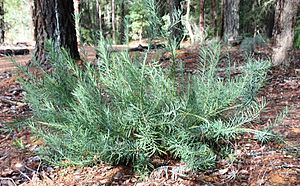Podocarpus drouynianus facts for kids
Quick facts for kids Podocarpus drouynianus |
|
|---|---|
 |
|
| Conservation status | |
| Scientific classification | |
| Genus: |
Podocarpus
|
| Species: |
drouynianus
|
The Podocarpus drouynianus is a special plant found only in the wet southwestern part of Western Australia. People often call it the emu berry, wild plum, or native plum. But don't let the name fool you, it's not a real plum! The Noongar people, who are the traditional owners of this land, call this plant koolah. It belongs to a group of plants called podocarps.
Contents
What Does the Emu Berry Look Like?
The emu berry plant is usually a shrub, which means it's a bushy plant with many branches growing from the ground, instead of one main trunk like a tree. It looks a lot like a conifer, which are plants that usually have needles and cones, like pine trees.
This plant typically grows to be about 0.75 to 3 meters (2.5 to 10 feet) tall. It can spread out to form clumps several meters wide. It grows very slowly. The bark is thin and feels like fiber. It starts green and then turns a reddish-brown color on the outside.
The leaves of the emu berry are like needles, about 4 to 8 centimeters (1.5 to 3 inches) long. They have sharp points and are green on top. If you look closely at the underside of the leaves, you'll see pale, whitish stripes. These stripes are where tiny openings called stomata are, which help the plant "breathe."
Instead of flowers, this plant has cones that look like berries. These cones have a soft, purple part called an aril, which is about 2 to 2.5 centimeters (0.8 to 1 inch) long. This aril is edible! Inside, there's usually one (sometimes two) seeds at the very tip, about 1 centimeter (0.4 inches) long.
Where Does the Emu Berry Grow?
The emu berry plant grows in the South West and Great Southern areas of Western Australia. You can find it on lower hillsides, in low-lying areas, and near creeks. It likes soils that are loamy (a mix of sand, silt, and clay), sandy, or gravelly.
This plant often grows as part of the understorey, which means it's one of the smaller plants found under taller trees. It grows well under jarrah and karri trees, which are types of eucalyptus trees. The emu berry mostly spreads by sending out new shoots from its roots.
Sadly, the total area where P. drouynianus grows has become smaller. This is because some forests have been cleared to make space for farms or to plant other types of trees that are not native to the area.
Growing Your Own Emu Berry
If you want to grow an emu berry plant, it's best to plant it where it gets some shade and plenty of water. Even though it likes water, it can also handle pretty dry conditions, which is unusual for plants in its family. It can survive hot temperatures up to 45 °C (113 °F) and grows well in full sun or partial shade.
When grown in gardens, the plant usually forms a rounded shape. It slowly reaches about 2 meters (6.5 feet) tall and 1.5 meters (5 feet) wide. The easiest way to grow new emu berry plants is by taking cuttings from an existing plant and planting them.
The plant's red, plum-like fruit is edible, but it doesn't have a very strong taste. However, it was an important food source for the first peoples of Southwest Australia. Even though the plant's fruit doesn't always appear reliably, people like to grow it for its attractive leaves. The long, leafy stems are also gathered and used by florists to make flower arrangements.
How Was the Emu Berry Named?
The emu berry species was first described by a botanist named Ferdinand von Mueller in 1864. He wrote about it in his book called Fragmenta Phytographiae Australiae.
This plant has a couple of other names that were used in the past, but are now considered synonyms (different names for the same species). These are Nageia drouyniana and Podocarpus drouyniana. The species name, drouynianus, was chosen to honor a famous person named Edouard Drouyn de Lhuys. He was a statesman, which means he was an important government official, and a member of the Institut de France.


